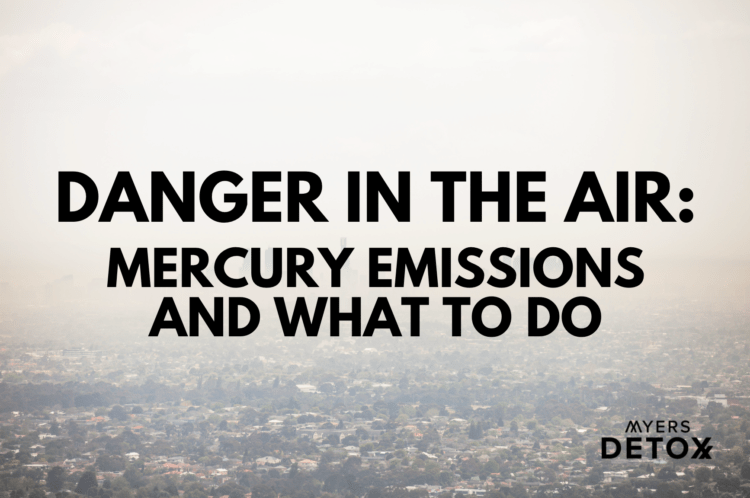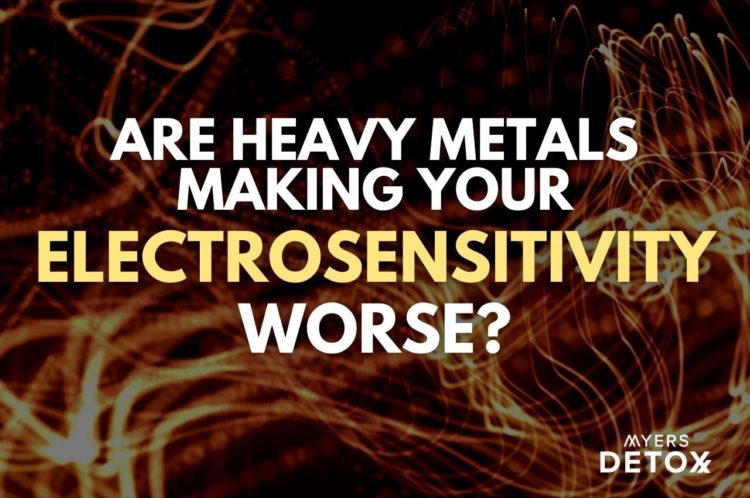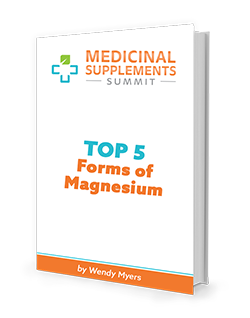Danger in the Air: Mercury Emissions and What to Do

The EPA just lowered the limits of mercury emissions. Here’s how to keep yourself safe.
Mercury is one of the most damaging heavy metals in the modern world. All of us are exposed to mercury on a regular basis — It’s in our food, water, air, and even our homes.
You’re exposed to mercury every day in small amounts, which makes it especially hard to detect. But over time, mercury builds up in your body – and if you don’t detox it, mercury will gradually sap your energy and one day can lead to symptoms and even serious health problems.
And now, mercury could pose a bigger threat than ever. The United States Environmental Protection Agency (EPA) just announced that it’s relaxing current laws and allowing the increase of mercury emission limits from power plants by up to 70%!!!
I was floored when I read this. How are we going backwards in environmental protections? I’ll tell you, it’s expensive for companies to clean up their act and they are lobbying Washington all the time to allow more dumping of toxins into our environment.
Coal-burning power plants are the single biggest contributor of mercury to our environment [1], and the EPA’s recent change to mercury limits is going to have major consequences for our health.
In the wake of this news, it is more important than ever that you have a daily detox strategy – I recommend you do something every day in your health regime towards avoiding mercury exposure and removing mercury from your toxic body burden.
This article can help. It covers:
- The new EPA laws increasing mercury emissions
- How mercury exposure saps your energy and makes you sick
- How to detox mercury and take control of your health
Toxic Overload: the EPA’s New Mercury Emissions Guidelines
In 2011, the Environmental Protection Agency (EPA) passed a law that dramatically tightened federal air pollution standards.
This was great news for our health. Mercury levels in air pollution were dangerously high, and the new law caused a 70% drop in mercury emissions from coal plants[2].
The EPA predicted that these stricter mercury emission guidelines would prevent 4,000-11,000 premature deaths, 4,700 heart attacks, and 130,000 asthma attacks every year[3].
Now, however, that law has been repealed.
Despite strong bipartisan opposition in Congress, as well as pushback from doctors and environmental experts, the EPA has announced that they plan to get rid of the stricter guidelines by mid-2020, allowing emissions to go back up to pre-2011 levels.
That will likely mean a 70% increase in environmental mercury from coal plants in the coming years — and if you aren’t careful, that increase could have a major effect on your wellbeing.
How Mercury Exposure Saps Your Energy and Makes You Sick
Mercury pollutes our water, food, and air[4]. Avoiding it is impossible. Accumulation in your body is unavoidable.
Most of us are exposed to mercury on a regular basis. To make things worse, mercury builds up in your fat stores, heart, brain and nervous system – and over time, small but regular exposure can lead to toxicity that saps your energy and leaves you sick[5].
Mercury toxicity symptoms are broad, and people often mistake mercury buildup for another health issue. You can find a comprehensive list of mercury toxicity symptoms here, but some of the most common symptoms include:
- Fatigue
- Brain fog
- Weight gain
- Immune dysfunction – mercury slows immune cell response
- Digestive and gut issues (mercury kills good gut bacteria)
- Skin problems like rashes, boils, acne and aging skin
- Heart disease
- Dementia
- Short-term memory loss/forgetfulness
- Depression
- Anxiety
- Insomnia
- Dizziness
- Respiratory issues
- Headaches and Migraines
- Neuropathy, numbness and tingling
3 Simple Ways to Decrease Your Mercury Exposure
With the new EPA guidelines, there’s going to be much more mercury pollution in the coming months, and it could last for years.
It’s essential that you limit your mercury exposure to protect yourself from mercury buildup. Here are three simple ways to decrease your mercury exposure and keep yourself safe.
1. Avoid High-Mercury Seafood
Mercury from coal-burning ends up accumulating in the environment, and water is one of the main places it settles[6].
When mercury makes it into water, aquatic plants absorb and store it. Small fish eat the plants, larger fish eat the small fish, and so on, causing mercury to move up the food chain.
The largest, longest-living fish eat lots of smaller fish, and each time they do, they absorb and store a little bit of mercury. This process is called bioaccumulation, and it’s a major source of mercury toxicity in people, because we tend to eat high-mercury fish from the top of the food chain.
Tuna , mackerel, swordfish, shark, orange roughy, and other large fish are packed with mercury, and you’re best off avoiding them. It’s worth noting that skipjack tuna, which is often used for canned tuna fish, is fine to eat — it only grows to about 40 pounds, and doesn’t bioaccumulate nearly as much mercury as larger tuna species, like those used in sushi.
The U.S. Food and Drug Administration (FDA) used to recommend eating high-mercury fish only once a week, but as mercury has become a bigger health concern, they’ve shifted their stance. They now recommend avoiding high-mercury fish altogether[7], which shows how serious mercury pollution has become.
To keep your mercury levels in check, your best bet is to avoid eating high-mercury and moderate-mercury fish entirely.
Fortunately, seafood doesn’t have to be off the table entirely. There are plenty of low-mercury fish that you can still eat. For a list of safe fish, check out my Seafood Survival Guide.
2. Remove Mercury Dental Amalgams
If you have mercury amalgam fillings, talk to a biological dentist about getting them removed. Mercury fillings can leach mercury into your system, and the problem worsens as the fillings get older and become less stable.
While mercury fillings are stable in theory, they interact with your body in ways that release mercury in small amounts over time.
For example, bacteria in your mouth can interact with mercury from dental amalgams. They liberate mercury and convert it into methylmercury, which is an especially toxic and easy-to-absorb form of mercury[8][9].
People with mercury fillings also have significantly higher levels of mercury in their saliva[10]. From saliva, mercury gets into your bloodstream, and eventually ends up in your brain[11].
And while mercury has a limited ability to cross the blood-brain barrier — a protective wall that tries to keep toxins away from your brain — it binds very strongly once it’s in your brain[12]. Mercury’s half-life in the human brain is estimated to be 20 years, versus 30-60 days in other tissues[13].
Even small, continuous brain exposure to mercury through dental fillings can have devastating effects over time. It’s essential that you get rid of mercury fillings as soon as you can, and that you detox mercury consistently to get it out of your system.
3. Be Aware of Air Pollution (Especially in Cities)
Mercury is a byproduct of fossil fuel combustion. Car emissions and smog from factories and industry release significant mercury into the air[14][15].
Do what you can to avoid polluted air — check your local air quality index periodically, and avoid spending too much time outside on days when air quality is low.
Of course, if you’re in a city, air pollution is unavoidable, and you’re most likely breathing in mercury every day. At that point, your best bet is to detox on a regular basis (learn how to detox mercury below).
These tips can help you limit how much mercury you absorb. However, limiting your mercury exposure will not completely protect you from ingesting mercury.
Why You Need to Detox Mercury
Even if you avoid major sources of mercury, like fish and dental fillings, you’re still absorbing small amounts of mercury throughout daily life, from car emissions, tap water, air pollution, and other sources.
And if you haven’t been actively detoxing for periods of your life, you likely have a lot of mercury stored in your body.
If you have unexplained fatigue, headaches, trouble concentrating, poor immunity, weight gain, or other symptoms, there’s a good chance it’s due to toxic mercury buildup. And with the EPA’s new mercury pollution guidelines, things are likely to get worse in the coming years.
That’s why it’s so important to detox mercury on a regular basis.
The Best Way to Detox Mercury
Mercury hides away in hard-to-reach parts of your brain and nervous system. If you mobilize too much of it at once, you can get even more sick. This is the biggest mistake people make when attempting to detox any heavy metal.
You need something that both mobilizes mercury and binds to it – deactivating it and pulling it from your body.
That’s why I formulated CitriCleanse. It’s a gentle, yet effective toxin binder that’s specifically designed to detox heavy metals like mercury.
CitriCleanse uses a 1-2-3 system to support heavy metal detox:
- Cilantro extract helps your body to naturally pull heavy metals from hidden places like fat stores and the liver[16].
- Grapefruit citrus pectin acts as a natural support binder – gently surrounding and removing toxins from the body[17].
- Fulvic acid and humic acid mineralize the body, pushing out and supporting your body as it displaces metals like mercury and protects you so they can’t do damage as they leave your system[18].
CitriCleanse is effective, but it’s also gentle enough for daily detoxifying. It’s easy to use, and it even tastes good — just mix it into water and drink it every morning.
If you’re worried about the new lax EPA guidelines, or you think you have mercury or another heavy metal hiding in your body, CitriCleanse can help. Give it a try; you’ll feel the difference within a few days.
*These statements have not been reviewed by the FDA. CitriCleanse is a dietary supplement and is not intended to diagnose, treat, cure, or prevent any disease. It is not intended to replace any medication or healing modality prescribed by your medical doctor. Please consult with your doctor before beginning a new supplement regimen.
Click Here for References+
- https://www.epa.gov/sites/production/files/2018-07/documents/nei2014v2_tsd_05jul2018.pdf
- https://www.nrdc.org/sites/default/files/benchmarking-air-emissions-of-the-100-largest-electric-power-producers-in-the-united-states-june-2018_2018-06-15.pdf
- https://www.epa.gov/mats/healthier-americans
- https://www.ncbi.nlm.nih.gov/pmc/articles/PMC3701261/
- https://www.ncbi.nlm.nih.gov/pmc/articles/PMC3988285/
- https://www.ncbi.nlm.nih.gov/pmc/articles/PMC3701261/
- https://www.fda.gov/food/consumers/advice-about-eating-fish
- https://www.ncbi.nlm.nih.gov/pubmed/6222462
- https://www.ncbi.nlm.nih.gov/pmc/articles/PMC6466133/
- https://www.ncbi.nlm.nih.gov/pubmed/11385194/
- https://www.ncbi.nlm.nih.gov/pubmed/2190116
- https://www.ncbi.nlm.nih.gov/pmc/articles/PMC6466133/
- https://www.ncbi.nlm.nih.gov/pubmed/23230464/
- https://www.ncbi.nlm.nih.gov/pmc/articles/PMC4880625/
- https://www.ncbi.nlm.nih.gov/pmc/articles/PMC5336545/
- https://www.ncbi.nlm.nih.gov/pmc/articles/PMC5446471/
- https://www.ncbi.nlm.nih.gov/pubmed/18616067
- https://www.ncbi.nlm.nih.gov/pubmed/24095965









